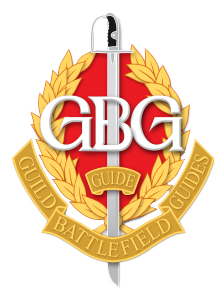Any reference to cavalry conjures up images of courageous horsemen charging across the battlefield running down the enemy but an image of Huntingdonshire Cyclist Battalion perhaps doesn’t have quite the same romantic magic. However, the role carried out by them was arguably just as important as in fact the breakthrough of the German lines which was expected and which the cavalry in WWI were meant to exploit never really happened.
Historically Britain has only ever had a small standing (full-time) army. The navy has always been ‘the Senior Service’. Army reserves comprised local volunteer territorial battalions. However, as a result of the army reorganisation in 1908, Huntingdonshire lost its only volunteer territorial battalion following its merger with the Bedfordshire Regiment. This was not popular locally and members of the local force association lobbied for the formation of a ‘Wheelman Battalion’ manned by recruits from Huntingdonshire.
Eventually, early in 1914 after much behind-the-scenes negotiation with the War Office, the local Association and the Bedfordshire regiment (who were concerned not to lose men to the new formation) permission was granted for the raising of the ‘Huntingdonshire Cyclist Battalion’. Although 2 extra companies had first to be raised to fill gaps in the Bedfordshire Regiment.
Now at the time of WWI, an infantry battalion at full strength consisted of just over 1000 men divided into 4 companies of about 250 men further divided into platoons and sections. However, the structure of the cyclist battalions was quite different. The Huntingdon Battalion was divided into 8 companies each drawing volunteers from a specific local area. A and B companies drew men from Huntingdon and Godmanchester, C from St Ives and Somersham, D from St Neots and Kimbolton, E from Ramsey and Warboys, F and G from Fletton and Peterborough and H from Yaxley and Farcet. This was as close to the famous ‘Pals Battalions’ as you could get. Each company had 50-60 men making up a total force of about 500 plus, including 17 motorcyclists and a band!
So what was the role of a cyclist battalion in general and Huntingdonshire Cyclist Battalion in particular? The idea of how best to use cyclists developed throughout the war. Initially, the idea was to use them for carrying despatches, then scouting for an infantry unit. There were those who wanted to use cyclist battalions at the front. In the event, armed (with a rifle) cyclists were used for coastal defence at home. Their mobility enables them to focus on a single point or area quickly. Such a unit could cover 80 miles a day at a time when an infantryman might march 20 miles a day or a cavalryman 40 miles ( and still have a horse to feed and bed down). Distances would be affected by the nature of the terrain but that applied across the board. However, how to make the best use of a cyclist force was never fully agreed upon. As noted above some advocated their use in the field in a tactical and operational role others proposed a purely scouting role and even then not as an independent unit but as part of the unit they were scouting for.
Within a few months of the formation of the Huntingdonshire Battalion war was declared, the Battalion was despatched to the Yorkshire and Lincolnshire coast for home defence. The Battalion covered an area between Scarborough in the north to Grimsby in the south. Their role was in carrying out coastal patrols, observing and reporting on any suspicious activity as well as observing enemy aircraft and naval ships. You may be aware that the German navy did shell or bomb parts of the east coast and ports including Whitby Scarborough and Great Yarmouth. During this period one new recruit was Charles Laughton who went on to become a famous Hollywood actor. In 1939 he starred as Quasimodo in ‘The Hunchback of Notre Dame’ although the bells he complained of in the film were not those of his colleagues in the battalion!
Back in Huntingdon, a second battalion was being raised and later even a third although that never reached operational strength. Fortunately or otherwise neither first nor second battalions were posted to France or Belgium and did not fight together as a single unit. However, men from the three battalions were transferred to other units including the Royal Warwickshire Regiment and the Machine Gun Corps as manpower shortages on the western front particularly after the battle of the Somme meant that other fighting units needed to be brought up to strength.
Although the Cyclist Battalion was disbanded after the war the name of the county was preserved in WWII as the 5th ( Huntingdonshire) Battalion, Northamptonshire Regiment.
I am indebted to my fellow member of the Western Front Association Martyn Smith for his work on the Huntingdonshire Cyclist Battalion which I have read as part of my research into this subject.


